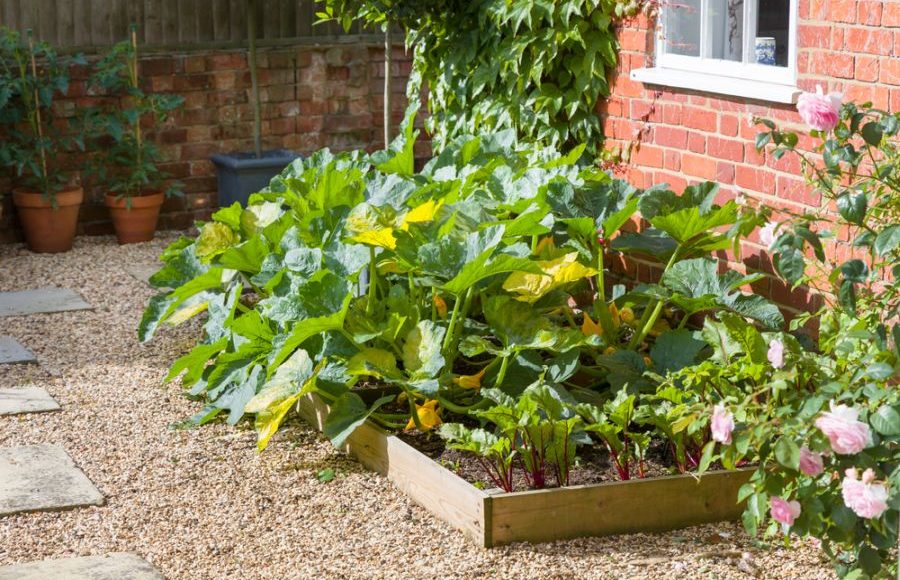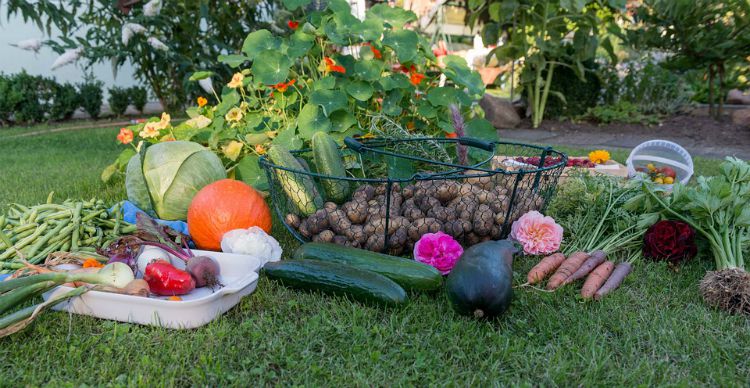Almost every household in the United States has a concrete drive that serves no other purpose than hosting a vehicle. However, in a crisis, or if you lack space for gardening, your driveway can also be turned into a vegetable garden rather easily.
Not only will this provide you with a ton of fresh produce, it can also become a gathering place for neighbors, a teaching center for children, and a project to change mindsets and spread the pleasure of gardening.
Just keep in mind, if you don’t have a driveway, you can also turn your deck or a patio into a fruitful garden. After all, necessity is the mother of invention and food is pretty important. In short, these plans are adaptable.
Location and planting options
The space you’ll use for your improvised garden needs to experience at least six hours of direct sunlight every day. Otherwise, for example, if sunlight exposure drops to four hours or less, it will have a devastating effect on most plants and you won’t harvest much. Putting time and effort into a non-productive garden is also quite depressing.
However, dirt is not available in your driveway and removing the concrete is impractical. So, what should one do? The answer is simple. Grow your garden in containers!
That’s because pretty much anything grown in a traditional garden can also grow in containers or straw bales. The key is to use the right container and understand your crops’ needs.
You can also use raised beds, hydroponics, or vertical gardening systems, but containers and straw bales require less work and, with some trial, patience, and a lot of experimentation, are also extremely flexible.
Container gardening
Container gardening is when your plants are grown in containers vs. the earth. The main advantage of which is that you can grow anywhere, in a more easily-managed space, with less need for bending and stretching.
Picking your containers
There are many container options available, and each type has its pros and cons. However, the thing to keep in mind is each container should allow proper drainage, and have the proper size required for the plant you want to grow in it. Here are some details regarding the various containers available on the market:
- Plastic pots are sturdy and cheap, but retain more heat vs. other pots, which can be detrimental to plant roots.
- Terra cotta pots are sturdy, and look nice, but due to their porous nature require more watering than average.
- Growing bags are affordable, provide good drainage and release more heat than traditional plastic pots. However they have a shorter life span compared to other containers and are less sturdy.
- Self-watering containers are ideal if you can’t water your garden regularly. They’re also sturdy but more expensive compared to other options.
Another thing to consider is that certain plant subspecies have more substantial root systems vs. the average. They’ll therefore require larger containers to hold them and more water and nutrition as a result. For example, if you plant tomato cultivars of an indeterminate nature (plants that continue to grow and fruit until they die) you’ll need a container with a 10-gallon capacity. However, if you grow determinate varieties (that die after they mature and fruit) or dwarf tomatoes you’ll need a 5-gallon container. Other notable examples include eggplants, peppers, and vine crops like cucumber, squash or melon).
Filling the containers
Using good quality soil is the key to your garden’s success. If you use poor quality soil, with too much or too little drainage, your crop will barely survive. If you decide to use soil from your backyard, you may also create problems for your plants since the soil may be infused with various diseases. That’s why I use a potting mix instead.
You can make a potting mix by mixing 1-part peat moss, 1-part topsoil or garden loam, and 1-part perlite or builder’s sand. You can also buy potting soil or potting mix from a garden center.
Some gardeners also recommend tossing the prior year’s used potting mix, and starting fresh each season but, in reality, there’s no need to do so unless your plants have suffered from a disease that originates in the roots. If you had plants that did well, you should be able to safely reuse the planting mix next season.
Watering and feeding
Your watering needs may also vary depending on what you grow, their growing stage, and seasonal weather. For example, a weekly watering may be enough for plants that are a few weeks old in the cooler days of spring. Nevertheless mature plants will often need to be watered daily. You might also notice they wilt during the hottest part of the day. A clear sign of thirst.
You can also use a soaker hose or install a drip irrigation system to reduce effort. It all depends on how many containers you have and their type since, as we established, some have better drainage than others.
One thing to remember is that frequent watering will also lead to a loss of nutrients through drainage. It is therefore recommended to feed any established plants (plants that are a month old or so) weekly using your plant food of choice at the recommended dosage.
Plant support
If you plan on growing vines, or tall-growing plants, in containers you must also provide additional support for stability. To do this, inserting a stake directly into the container will do a good job until the plants start to fruit. After that, another option is to place such containers adjacent to your lawn and then drive a stake into the lawn’s soil. You can then tie the plants to this adjacent stake for support.
You can also use cages or similar types of support that can be inserted over the plants inside of their containers. These are more stable than simple stakes but may become unstable and topple when the plant matures.
Diseases and critters
Compared to traditional gardening, some diseases are far less common in container gardening. For example, those which are soil based. Even so, many others are airborne and will similarly affect your plants.
As for pests and critters, the vertical space between the ground and soil level may offer some protection against slugs and rabbits or mice, but it’s not a sure thing. In most cases, you will have to employ the same tactics to get rid of disease and critters as you do with traditional gardening.
Straw bale gardening
Straw bale gardening was invented in 1950. However, it is now seen as a new and “modern” technique thanks to a reemergence on social media over the last two decades. Mostly since it can be utilized on all surface types. Without soil. Which is a godsend in, say, urban areas or those with infertile soil.
Picking your bales
Herein, the most important aspect is to differentiate between straw and hay bales. For example, straw bales are tightly packed bundles of hollow stems, and the most commonly used and widely available are those made of wheat. Hay bales, on the other hand, are composed of bundled grass and not recommended to use since they contain seeds which could compete with your plants.
Most folks get their bales from big-box hardware or feed and supply stores. However, you must also confirm that these bales do not contain herbicides if so. Otherwise you’ll risk killing your plants. So, ask your source.
Plants to grow and other recommendations
There are many plants you can grow in straw bales but tall veggies, such as corn or large vining plants, are not ideal since they can topple and thereby demand extra support. Other factors to consider are how much sunlight you get, the space available between bales, and how much time you have to maintain them.
As a quick tip, you should grow only two tomato plants or two pepper plants or eggplants for each bale. For all other crops you can maintain the same spacing as for traditional gardening.
It is also recommended to prepare your bales at least two weeks before you plant, and to position them as you would regular containers. Once in place, you’ll then need to create a proper root environment for your plants to grow in. This can be achieved by breaking down any stiff and dry straws with the help of added nitrogen.
To do this add a half cup of garden fertilizer, or three cups of organic fertilizer, to the bale and soak it every day for several days. Some gardeners will also add blood meal since it’s an organic source of nitrogen. Just keep in mind this has less nitrogen per volume vs. a non-organic source.
A 10-10-10 fertilizer is also recommended. However, if you decide to use an organic alternative keep in mind that due to a lower percentage of N-P-K (nitrogen, phosphorus, and potassium) you will likely need to add more or even double the amount.
Here is how you should prepare the bales:
- On days 1, 3, and 5 sprinkle ½ cup of 29-0-5 treatment over each bale or 1 cup of blood meal, then water the bales until they are saturated. The water should run out the bottom.
- On days 2,3, and 6, deep watering of the bales is recommended. Usually, twice per day is enough, but make sure the bales are saturated after each watering.
- On days 7,8, and 9, apply half the quantity you used for the initial nitrogen treatment and water the bales deeply.
- On day 10, add 1 cup of fertilizer or 2 cups if you use an organic fertilizer at half the strength. Water each bale deeply.
- On days 11 to 14, deep watering is recommended.
- On day 14 you can start planting after the watering.
Regarding the planting stage, you can either use seedlings or seeds. Seedlings are usually recommended for crops that take a long time to develop from seed. For anything else, you can use seeds.
Such seedlings should be removed from their container and then planted into the bales as deeply as you can. You will also need a trowel to create a hole in the bale for each seedling. Fill the gaps with planting mix and mulch around the plant with shredded leaves, shredded bark, or grass clippings. Then water deeply at the base of the plant.
If you plan on sowing seeds, add a 2- or 3-inch layer of planting mix to the top of the straw bale. Patting the planting mix gently in place is also recommended so that the seed can be sown in a compacted medium. Sow the seed at the recommended depth and spacing, then gently water each seed. Depending on what plants you’ve sown, you may also need to have a strict water schedule since certain seeds will otherwise die of thirst.
A word of advice: one thing you need to keep in mind is to avoid cutting the string of the bale since it’s the main support that holds the straws together. Some folks are making this mistake, and they end up with a pile of straws that’s no longer usable as a planting medium. As for the string arrangement, bales with strings on the side are slightly taller, and those with strings on top are usually smaller but more stable.
Watering and feeding
Compared to other containers straw bales need a tight watering schedule since they will dry out quickly on hot sunny days. When the plants mature you will therefore need to water the bales daily to keep thirsty roots happy. Some folks, to avoid extra work and provide consistent water for the straw bales, will usually run a drip-feed hose down the center of the bales and cover it with planting mix.
You will also need to feed your plants weekly. Although you can use any plant food you like. So long as you follow the label’s instructions. Failure to do this could lead to nutrient depletion and crop death.
Plant support
Working with bales provides plenty of room for creativity and you can even stack bales on top of each other to provide additional plant support. However driving stakes through the bales will not work since the bales will soften. However, you can place containers with dirt next to the bales and place stakes (or any other support) in those. You can even use cages with your bales as long as you anchor them to the stakes in these pots with soil.
Pest and bale disposal
One thing folks encounter when container gardening is mice and rats, or other pests taking up residence in their bales. If this happens you should employ a pest deterrent similar to those used for traditional gardening.
Once the growing season is over you will end up with completely or partially collapsed bales. You will also have a mass or compost or loam you can use as compost or for mulching if you had healthy plants growing in the bales.
Concluding
With the help of containers you can turn any driveway into a productive garden. As you saw in this article you have many options when it comes to choosing your containers. Including organic ones like straw bales.
You may currently use your driveway just for parking but it’s also good to know you have options for turning it into an edible oasis if need be. Just picture your home overflowing with fresh produce. Sounds great, right?







radarphos | January 13, 2022
|
Thanks. I haven’t read such good ideas in one article, and one place, in a long time.
Richard H | January 13, 2022
|
It is nice to have people that think the same way.
Richard H | January 13, 2022
|
We have a stock pile small but growing. And we have a garden this year that will produce a lot of food..